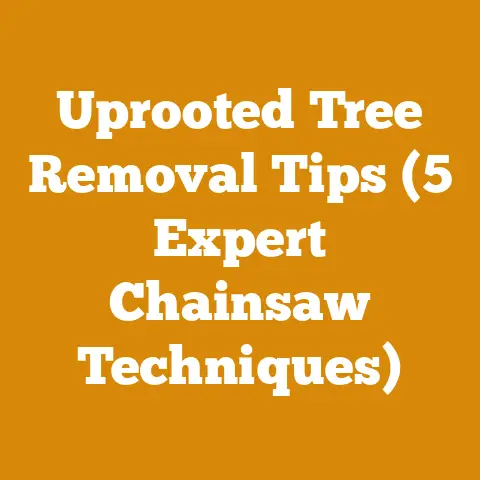Backhoe Outrigger Tips (5 Pro Tricks for Wood Processing)
Backhoe Outrigger Tips (5 Pro Tricks for Wood Processing)
I remember the first time I saw a seasoned logger, let’s call him Old Man Hemlock, use a backhoe with outriggers to maneuver a massive white oak log. It wasn’t just about lifting; it was about precision, safety, and efficiency. He made it look like an extension of his own body, a dance of hydraulics and timber. That day, I realized the backhoe wasn’t just for digging; it was a wood processing Swiss Army knife. In this article, I’ll share five pro tricks I’ve learned over the years, turning that clunky machine into a nimble partner in your wood processing endeavors. We’ll also delve into the costs associated with using this equipment, helping you budget effectively for your projects.
Understanding Backhoe Outriggers: The Foundation of Safe and Efficient Wood Processing
Outriggers, those stabilizing legs that extend from the backhoe, are the unsung heroes of wood processing. They transform a potentially wobbly machine into a stable platform, enabling you to lift heavy logs, swing them into position for splitting, and even assist in stacking firewood with remarkable control.
Why Outriggers Matter in Wood Processing
- Enhanced Stability: This is paramount, especially when dealing with uneven terrain or heavy loads. Without properly deployed outriggers, the backhoe can become unstable, increasing the risk of tipping or accidents.
- Increased Lifting Capacity: By distributing the weight of the load across a wider base, outriggers allow you to safely lift heavier logs than you could without them.
- Improved Precision: A stable platform translates to more precise movements. You can accurately position logs for sawing, splitting, or stacking, minimizing wasted effort and material.
- Operator Safety: This is non-negotiable. Properly deployed outriggers significantly reduce the risk of accidents, protecting you and your crew.
Cost Considerations: Backhoe Ownership vs. Rental
Before we dive into the tricks, let’s talk brass tacks: the cost of using a backhoe. This is where the “should I buy or rent?” question comes into play.
Backhoe Ownership:
- Initial Investment: New backhoes can range from $40,000 to $150,000 or more, depending on size, features, and brand. Used models can be found for less, but require careful inspection and potential repair costs.
- Maintenance Costs: Expect to spend 1-3% of the initial purchase price annually on maintenance. This includes oil changes, filter replacements, hydraulic fluid, tire maintenance, and potential repairs.
- Insurance: Annual insurance costs can range from $500 to $2,000, depending on your location and coverage.
- Depreciation: Backhoes depreciate over time, typically losing 10-20% of their value in the first few years.
- Storage: You’ll need a secure place to store the backhoe, which may involve additional costs for a shed or covered area.
Backhoe Rental:
- Hourly Rates: Expect to pay $75 to $150 per hour, depending on the size of the backhoe and your location.
- Daily Rates: Daily rentals typically range from $400 to $800.
- Weekly Rates: Weekly rentals can cost between $1,500 and $3,000.
- Delivery Fees: Factor in delivery and pickup fees, which can add $100 to $300 to the total cost.
- Insurance: Rental companies typically include insurance in the rental fee, but it’s important to verify the coverage.
My Take:
For occasional wood processing projects, renting is often the more economical choice. However, if you’re a professional logger, firewood supplier, or frequently involved in wood processing, ownership might make more sense in the long run. I once did a calculation for a friend who ran a small firewood business. He was renting a backhoe for about 40 days a year. Over five years, the rental costs would have exceeded the purchase price of a decent used machine.
Data Point: According to a 2023 report by EquipmentWatch, the average hourly rental rate for a mid-sized backhoe in the United States is $95.
5 Pro Tricks for Backhoe Outrigger Mastery in Wood Processing
Now, let’s get to the nitty-gritty. These are the tricks I wish someone had told me when I first started using a backhoe for wood processing.
Trick #1: The “Three-Point Stance” for Uneven Terrain
This is crucial when working on slopes or uneven ground. The goal is to create a stable, level platform by strategically positioning the outriggers and front loader bucket.
- Assess the Terrain: Carefully examine the area where you’ll be working. Identify any slopes, bumps, or soft spots.
- Position the Backhoe: Park the backhoe as level as possible to begin with.
- Deploy the Outriggers: Extend the outriggers on the higher side of the slope first, lowering them until they make solid contact with the ground.
- Use the Front Loader: Use the front loader bucket to support the lower side of the backhoe. Lower the bucket until it rests firmly on the ground, providing additional stability.
- Adjust as Needed: Fine-tune the outrigger and front loader positions until the backhoe is level and stable. Use a spirit level on the backhoe’s frame to ensure accuracy.
Why This Works:
This technique distributes the weight of the backhoe and the log across three points – the two outriggers and the front loader bucket – creating a stable tripod.
Cost Implication:
Using this technique properly minimizes the risk of tipping or damage to the backhoe, saving you potential repair costs, which can easily run into thousands of dollars. I know someone who neglected this and ended up with a bent axle after a near-tip. The repair bill was eye-watering.
Trick #2: “The Gentle Touch” – Protecting Your Work Surface
Outriggers can exert significant pressure, potentially damaging lawns, driveways, or other surfaces. Here’s how to minimize the impact:
- Use Outrigger Pads: These are large, flat pads made of wood, rubber, or composite materials that distribute the weight of the outriggers over a wider area. You can buy pre-made pads or build your own.
- Choose the Right Material: Select pad material based on the surface you’re working on. Wood pads are suitable for most surfaces, while rubber pads are ideal for protecting delicate areas like lawns or paved driveways.
- Proper Placement: Ensure the outriggers are centered on the pads.
- Monitor for Sinking: Keep an eye on the pads as you work. If they start to sink into the ground, reposition them or use larger pads.
Why This Works:
Outrigger pads reduce the pressure exerted on the ground, preventing damage and minimizing the risk of the outriggers sinking into soft soil.
Cost Implication:
Replacing a damaged driveway or repairing a torn-up lawn can be surprisingly expensive. Outrigger pads are a relatively inexpensive investment that can save you a lot of money and hassle in the long run. I once had to re-seed an entire lawn because I didn’t use pads – a costly lesson learned.
Data Point: A set of four high-quality outrigger pads typically costs between $200 and $500, depending on the size and material.
Trick #3: “The Pre-Lift Check” – Ensuring Stability Before You Lift
Before lifting any log, perform a thorough stability check. This is a critical safety measure that can prevent accidents.
- Visual Inspection: Visually inspect the outriggers and front loader bucket to ensure they are properly positioned and making solid contact with the ground.
- Rocking Test: Gently rock the backhoe back and forth to check for any instability. If the machine rocks excessively, adjust the outriggers or front loader position until it’s stable.
- Test Lift: Perform a small test lift with the log, raising it only a few inches off the ground. Observe the backhoe for any signs of instability.
- Adjust as Needed: If the backhoe feels unstable during the test lift, lower the log and readjust the outriggers or front loader position.
Why This Works:
This process identifies any potential stability issues before you lift the full weight of the log, giving you a chance to correct them before an accident occurs.
Cost Implication:
Preventing accidents is the most important cost-saving measure you can take. A serious accident can result in injuries, property damage, and significant financial losses. This simple pre-lift check can save you from a world of trouble. I’ve seen firsthand the aftermath of a tipped backhoe – it’s not pretty, and the costs are astronomical.
Trick #4: “The Gradual Extension” – Avoiding Overextension
Overextending the outriggers can create a weak point, reducing their stability and increasing the risk of damage.
- Know Your Limits: Familiarize yourself with the backhoe’s operating manual and understand the maximum extension limits for the outriggers.
- Avoid Full Extension: As a general rule, avoid fully extending the outriggers unless absolutely necessary.
- Maintain Overlap: Ensure there is sufficient overlap between the inner and outer sections of the outriggers. This provides added strength and stability.
- Monitor for Stress: Listen for any unusual noises or creaking sounds from the outriggers. These can be signs of overextension or stress.
Why This Works:
Maintaining a safe range of extension ensures the outriggers are operating within their design limits, maximizing their strength and stability.
Cost Implication:
Overextending the outriggers can damage the hydraulic cylinders, bending the outrigger arms, or even causing them to break. Repairing or replacing these components can be expensive. I once saw a logger try to push the limits, and he ended up with a bent outrigger arm that cost thousands to repair.
Trick #5: “The Smart Retraction” – Avoiding Obstacles
Retracting the outriggers requires just as much care as extending them. You need to be mindful of obstacles and potential hazards.
- Clear the Area: Before retracting the outriggers, visually inspect the area around them for any obstacles, such as rocks, tree roots, or debris.
- Lift Slightly: Slightly lift the backhoe with the front loader or boom before retracting the outriggers. This takes the weight off the outriggers and makes them easier to retract.
- Slow and Steady: Retract the outriggers slowly and steadily, paying attention to any resistance or binding.
- Reposition as Needed: If an outrigger encounters an obstacle, stop retracting it and reposition the backhoe slightly to clear the obstacle.
Why This Works:
This prevents damage to the outriggers and avoids creating a tripping hazard when moving the backhoe.
Cost Implication:
Damaging an outrigger during retraction can result in costly repairs. Additionally, leaving an outrigger partially extended can create a tripping hazard for yourself or others, potentially leading to injuries and liability claims. I know a guy who tripped over a partially retracted outrigger and broke his wrist – a painful and expensive reminder to be careful.
Budgeting for Wood Processing: A Deeper Dive into Costs
Now that we’ve covered the outrigger tricks, let’s delve deeper into the costs associated with wood processing. As I mentioned earlier, these costs can vary significantly depending on a number of factors.
Factors Affecting Wood Processing Costs:
- Wood Species: Hardwoods like oak and maple are generally more expensive to process than softwoods like pine and fir. They require more power to saw and split, increasing fuel consumption and potentially wear and tear on your equipment.
- Wood Quality: The presence of knots, rot, or other defects can significantly increase processing time and effort.
- Location Accessibility: The ease of access to the wood source can impact transportation costs. If you have to haul logs over long distances or through difficult terrain, your fuel and labor costs will be higher.
- Seasonality: The time of year can affect wood processing costs. During the wet season, wood is heavier and more difficult to handle. Freezing temperatures can also make equipment harder to start and operate.
- Labor Costs: Whether you’re hiring a logging crew or doing the work yourself, labor is a significant cost factor.
- Equipment Costs: The cost of purchasing or renting equipment, such as chainsaws, log splitters, and backhoes, can significantly impact your budget.
- Permits and Regulations: Depending on your location, you may need permits to harvest timber or operate certain types of equipment. These permits can add to your overall costs.
Breaking Down the Cost Components:
Let’s break down the cost components of a typical wood processing project:
-
Timber Purchase or Harvesting Costs:
- Timber Purchase: If you’re purchasing timber, the cost will depend on the species, quality, and volume. Timber prices vary widely depending on location and market conditions.
- Data Point: According to the U.S. Forest Service, the average stumpage price (the price paid to the landowner for standing timber) for sawtimber in the Southern United States in 2023 was $35 per thousand board feet.
- Harvesting Costs: If you’re harvesting timber yourself, you’ll need to factor in the cost of felling trees, limbing, bucking (cutting into logs), and skidding (dragging logs to a central location).
- Labor: Depending on the size of the job, hiring a small logging crew can range from $200 – $1000 per day.
- Fuel: Chainsaw fuel, skidder fuel, etc., can add up to $50-$200 per day.
- Chainsaw maintenance: Chain sharpening, bar oil, replacement chains, etc. can add $20-$50 per day.
-
Tool Costs:
-
Chainsaw: Chainsaws range in price from a few hundred dollars for a basic model to several thousand dollars for a professional-grade saw.
- Cost: $200-$2000+
- Maintenance: Regular maintenance, such as sharpening the chain, cleaning the air filter, and replacing spark plugs, is essential for keeping your chainsaw running smoothly.
- Log Splitter: Log splitters can be manual, gas-powered, or electric. Gas-powered splitters are typically more powerful and can handle larger logs, but they also require more maintenance.
- Cost: $200-$4000+
- Maintenance: Hydraulic fluid changes, engine maintenance, etc.
- Backhoe: As discussed earlier, the cost of using a backhoe can vary depending on whether you own or rent it.
-
Labor Wages:
-
If you’re hiring a logging crew or firewood handlers, you’ll need to pay them competitive wages. Labor costs vary depending on location and experience.
- Data Point: According to the Bureau of Labor Statistics, the median hourly wage for logging workers in the United States in May 2022 was $20.53.
-
Permits (If Applicable):
-
Depending on your location and the scale of your project, you may need permits to harvest timber or operate certain types of equipment. The cost of these permits can vary widely.
- Timber Purchase: If you’re purchasing timber, the cost will depend on the species, quality, and volume. Timber prices vary widely depending on location and market conditions.
Cost Optimization and Budget Management Tips:
Here are some practical tips for optimizing costs and managing your budget effectively:
- Shop Around for Timber: Get quotes from multiple timber suppliers to ensure you’re getting the best price.
- Negotiate Prices: Don’t be afraid to negotiate prices with timber suppliers, equipment rental companies, and labor providers.
- Maintain Your Equipment: Regular maintenance can prevent costly repairs and extend the life of your equipment.
- Do Some of the Work Yourself: If you’re on a tight budget, consider doing some of the work yourself, such as felling trees, limbing, or stacking firewood.
- Consider Used Equipment: Purchasing used equipment can save you a significant amount of money compared to buying new.
- Plan Ahead: Careful planning can help you avoid unexpected costs and delays.
- Track Your Expenses: Keep track of all your expenses to ensure you’re staying within budget.
- Use Technology: Employing technology to assist in planning can help reduce costs.
Relevant Calculations and Formulas:
Here are a few relevant calculations and formulas that can help you estimate costs and manage your project effectively:
-
Estimating Volume of Logs:
- Doyle Log Scale: (Small end diameter in inches – 4) squared, multiplied by the length in feet, divided by 16. This is a common log scaling method in the Eastern United States.
- International 1/4-inch Log Scale: A more accurate log scaling method that takes into account taper and other factors.
- Cubic Volume: Pi multiplied by the radius squared, multiplied by the length. This is a simple way to estimate the cubic volume of a log.
-
Estimating Drying Time:
-
Drying time depends on several factors, including wood species, thickness, moisture content, and climate. As a general rule, hardwoods take longer to dry than softwoods.
- Air Drying: Air drying typically takes several months to a year, depending on the species and thickness of the wood.
- Kiln Drying: Kiln drying can significantly reduce drying time, but it also adds to the cost.
Challenges Faced by Small-Scale Loggers and Firewood Suppliers:
Small-scale loggers and firewood suppliers face a number of challenges, including:
Here are some actionable takeaways and next steps:
- Assess Your Needs: Determine whether you need to purchase or rent a backhoe based on the frequency and scale of your wood processing projects.
- Practice the Tricks: Practice the five pro tricks outlined in this article to improve your backhoe skills and ensure safe and efficient operation.
- Develop a Budget: Create a detailed budget that includes all of the cost components discussed in this article.
- Shop Around: Get quotes from multiple suppliers and negotiate prices to optimize your costs.
- Stay Informed: Stay up-to-date on industry trends, regulations, and best practices to improve your wood processing operations.
Wood processing can be a rewarding and profitable endeavor, but it requires careful planning, attention to detail, and a commitment to safety. By following the tips and strategies outlined in this article, you can increase your efficiency, reduce your costs, and achieve your wood processing goals. And remember, Old Man Hemlock would always say, “Measure twice, cut once… and always respect the machine.”






